tire pressure Oldsmobile Cutlass Supreme 1993 Owner's Manuals
[x] Cancel search | Manufacturer: OLDSMOBILE, Model Year: 1993, Model line: Cutlass Supreme, Model: Oldsmobile Cutlass Supreme 1993Pages: 340, PDF Size: 16.21 MB
Page 152 of 340

Your Driving and the Road
150
Anti-Lock Brakes (CONT.)
And this light on the instrument panel
will go on when you start your vehicle.
When you start your vehicle and begin
to drive away you may hear a
momentary motor or clicking noise and
you may even notice that your brake
pedal moves a little while this is going
on. This is the
ABS system testing itself.
If you have your foot on the brake
pedal, this check won’t happen until the
vehicle goes about
4 mph (6 lm/h) or
until you take your foot off the brake
pedal.
You’ll also hear a clicking noise the
next time the vehicle goes about
4 mph
(6 lun/h).
If there’s a problem with the anti-lock
brake system, the anti-lock brake
system warning light will stay on or
flash. See the
Index under Anti-Lock
Brake System Warning Light.
Here’s how anti-lock works. Let’s say
the road is wet. You’re driving safely.
Suddenly an animal jumps out in front
of you.
You slam on the brakes. Here’s what
happens with
ABS.
A computer senses that wheels are
slowing down. The computer separately
works the brakes at each front wheel
and at the rear wheels.
The anti-lock system can change the
brake pressure faster than any driver
could. The computer is programmed to
make the most of available tire and road
conditions.
Page 161 of 340
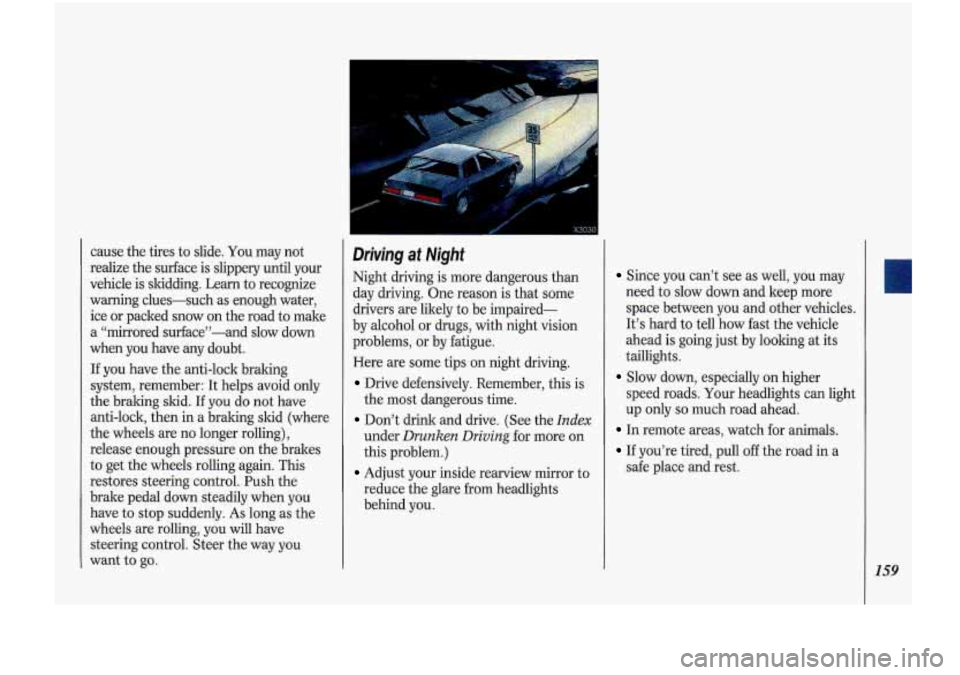
cause the tires to slide. You may not
realize the surface is slippery until your
vehicle is skidding. Learn to recognize
warning clues-such as enough water,
ice or packed snow on the road to make
a “mirrored surface”-and slow down
when you have any doubt.
If you have the anti-lock braking
system, remember: It helps avoid only
the braking skid.
If you do not have
anti-lock, then in a braking skid (where
the wheels are no longer rolling),
release enough pressure on the brakes
to get the wheels rolling again. This
restores steering control. Push the
brake pedal down steadily when you
have to stop suddenly. As long as the
wheels are rolling, you will have
steering control. Steer the way you
want to go.
I .@ i 7“
Driving at Night
Night driving is more dangerous than
day driving. One reason is that some
drivers are likely to be impaired-
by alcohol or drugs, with night vision
problems, or by fatigue.
Here are some tips on night driving.
Drive defensively. Remember, this is
the most dangerous time.
Don’t drink and drive. (See the Index
under Drunken Driving for more on
this problem.)
Adjust your inside rearview mirror to
reduce the glare from headlights
behind you.
Since you can’t see as well, you may
need to slow down and keep more
space between you and other vehicles.
It’s hard to tell how fast the vehicle
ahead is going just by looking at its
taillights.
speed roads. Your headlights can light
up only
so much road ahead.
Slow down, especially on higher
In remote areas, watch for animals.
If you’re tired, pull off the road in a
safe place and rest.
1
159
Page 170 of 340

Your Driving and the Road
Driving a Long Distance
Although most long trips today are
made on freeways, there are still many
made on regular highways.
Long-distance driving on freeways and
regular highways is the same
in some
ways. The trip has to be planned and
the vehicle prepared, you drive at
higher-than-city speeds, and there
are
longer turns behind the wheel. You’ll
enjoy your trip more if you and your
vehicle are in good shape. Here are
some tips for a successful long trip.
Before Leaving on a Long Trip
Make sure you’re ready. Try to be well
rested. If you must start when you’re
not fresh-such as after a day’s work
don’t plan to make too many miles that
first part of the journey. Wear
comfortable clothing and shoes you can
easily drive in.
Is your vehicle ready for a long trip? If
you keep it serviced and maintained, it’s
ready to go. If it needs service, have it
done before starting out. Of course,
you’ll find experienced and able service
experts in Oldsmobile dealerships all
across North America. They’ll be ready
and willing to help if you need it. Here are
some things you can check
before a trip:
Windshield Washer Fluid: Is the
reservoir
full? Are all windows clean
inside and outside?
shape? Have you checked
all levels?
the lenses clean?
safe, trouble-free trip. Is the tread
good enough for long-distance
driving?
Are the tires all inflated to
the recommended pressure?
Weather Forecasts: What’s the
weather outlook along your route?
Should you delay your trip a short
time to avoid a major storm system?
Maps: Do you have up-to-date maps?
Wiper Blades: Are they in good
Fuel, Engine Oil, Other Fluids:
Lights: Are they all working? Are
Tires: They are vitally important to a
Page 206 of 340
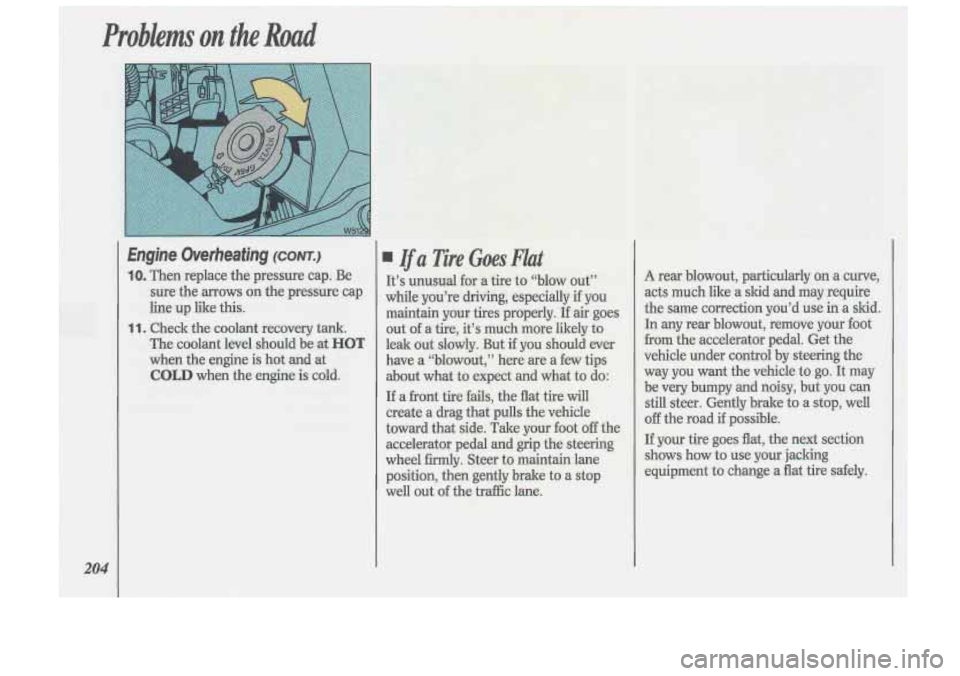
204
Problems on the Road
Engine Overheating (cow.)
IO. Then replace the pressure cap. Be
sure the
arrows on the pressure cap
line up like this.
1 1. Check the coolant recovery tank.
The coolant level should be at
HOT
when the engine is hot and at
COLD when the engine is cold.
Ifa Tire Goes Flat
It’s unusual for a tire to (‘blow out’’
while you’re driving, especially if you
maintain your tires properly. If air goes
out
of a tire, it’s much more likely to
leak out slowly. But
if you should ever
have a “blowout,” here are a few tips
about what to expect and what to do:
If a front tire fails, the flat tire will
create a drag that pulls the vehicle
toward that side. Take your foot
off the
accelerator pedal and
grip the steering
wheel firmly. Steer to maintain lane
position, then gently brake to a stop
well out of the trafEic lane.
A rear blowout, particularly on a curve,
acts much like a skid and may require
the same correction you’d use in a skid.
In any rear blowout, remove your foot
from the accelerator pedal. Get the
vehicle under control by steering the
way you want the vehicle to go. It may
be very bumpy and noisy, but you can
still steer. Gently brake to a stop, well
off the road if possible.
If your tire goes flat, the
next section
shows how to use your jacking
equipment to change a flat tire safely.
Page 213 of 340
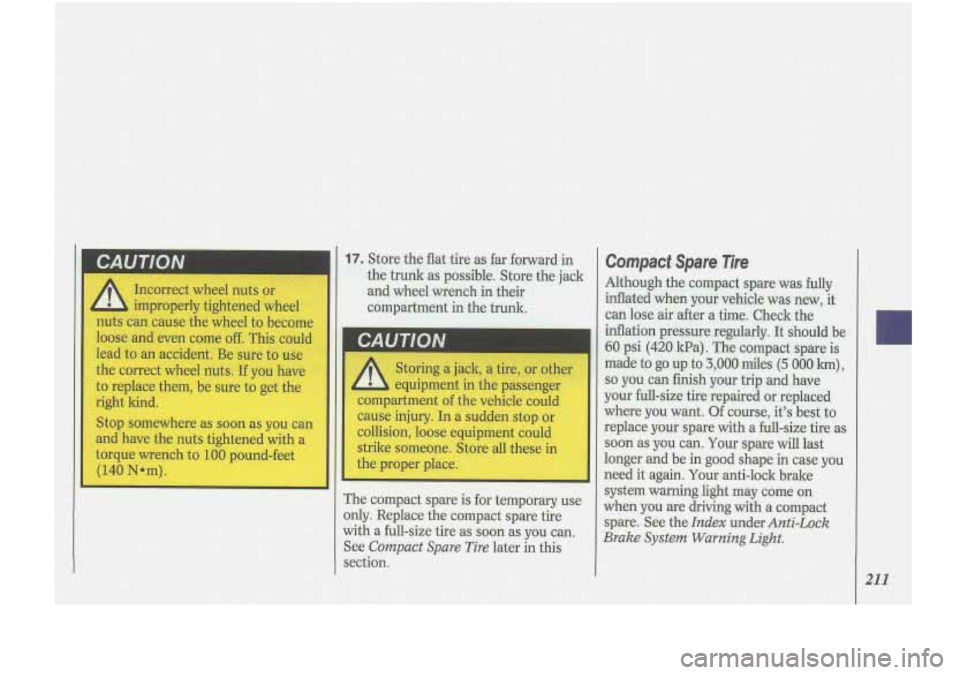
17. Store the flat tire as far forward in
the trunk
as possible. Store the jack
and wheel wrench in their
compartment in the trunk.
only. Replace the compact spare t&e
with a full-size tire
as soon as you can.
See
Compact Spare Tire later in this
section.
Compact Spare Tire
Although the compact spare was fully
inflated when your vehicle was new,
it
can lose air after a time. Check the
inflation pressure regularly. It should be
60 psi (420 1rPa). The compact spare is
made to
go up to 3,000 miles (5 000 km), ' so you can finish your trip and have
your full-size tire repaired or replaced
where you want. Of course, it's best to
replace your spare with a full-size tire as
soon as you can. Your spare will last
longer and be in
good shape in case you
need it again. Your anti-lock brake
2LI
Page 252 of 340
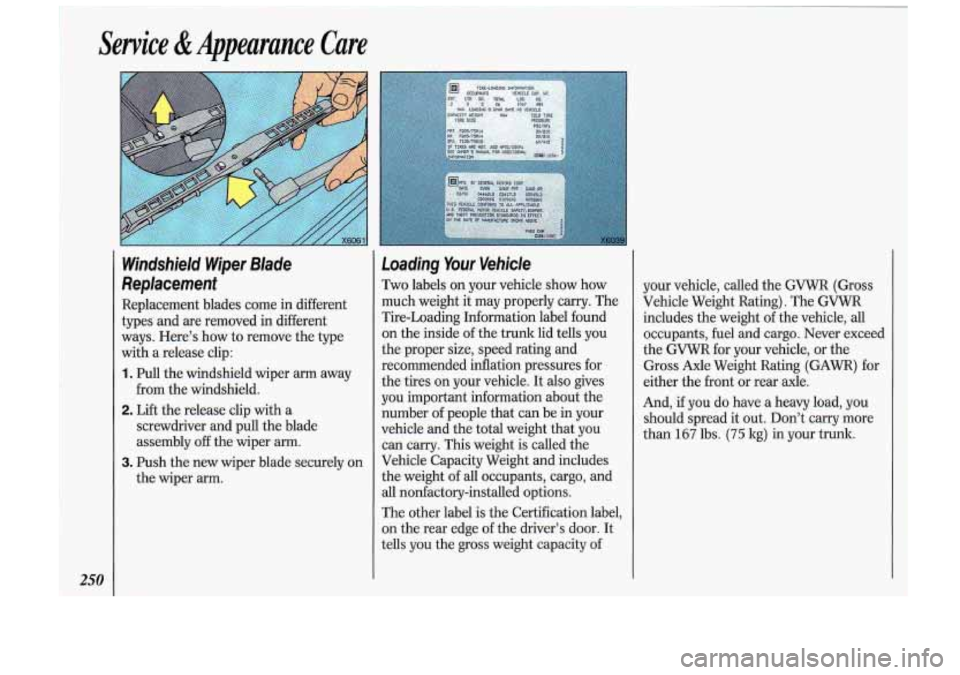
Sewice & Appearance Care
Windshield Wper Blade
Replacement
Replacement blades come in different
types and are removed
in different
ways. Here’s how to remove the type
with a release clip:
1. Pull the windshield wiper arm away
2. Lift the release clip with a
from the windshield.
screwdriver and
pull the blade
assembly
off the wiper arm.
the wiper m.
3. Push the new wiper blade securely on
Loading Your Vehicle
Two labels on your vehicle show how
much weight it may properly carry. The
Tire-Loading Information label found on the inside
of the trunlc lid tells you
the proper size, speed rating and
recommended inflation pressures for
the tires on your vehicle. It
also gives
you important information about the
number
of people that can be in your
vehicle and the total weight that you
can carry. This weight is called the
Vehicle Capacity Weight and includes
the weight
of all occupants, cargo, and
all nonfactory-installed options.
The other label is the Certification label,
on the rear edge
of the driver’s door. It
tells you the gross weight capacity
of
your vehicle, ded the GVWR (Gross
Vehicle Weight Rating). The GVWR
includes the weight of the vehicle,
all
occupants, fuel and cargo. Never exceed
the
GVWR for your vehicle, or the
Gross Axle~Weight Rating (GAWR) for
either the front
or rear axle.
And,
if you do have a heavy load, you
should spread it out. Don’t cany
more
than 167 lbs, (75 kg) in your trunk.
Page 254 of 340
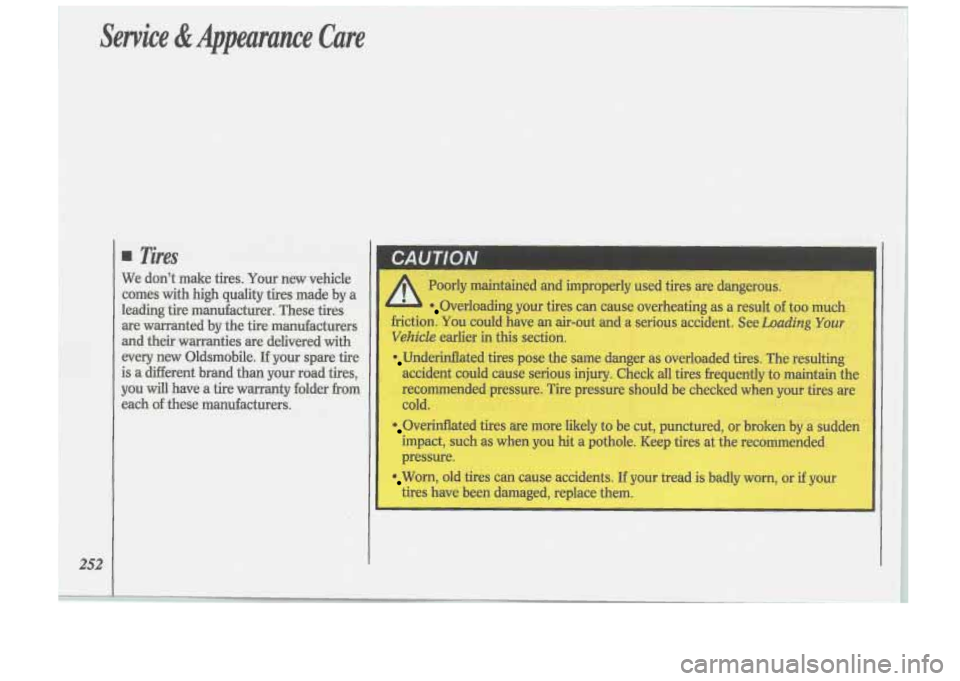
Poorly maintained and improperly used tires are dangerous.
Overloading your tires can cause overheating as a result of too much
friction. You could have an air-out and a serious accident. See
Loading Your
Vehicle earlier in this section.
Underinflated tires pose the same danger as overloaded tires. The resulting
accident could cause serious injury. Check all tires frequently to maintain the
recommended pressure. Tire pressure should be checked when your tires are
cold.
Overinflated tires are more likely to be cut, punctured, or broken by a sudden
impact, such as when you hit a pothole. Keep tires at the recommended
pressure.
Worn, old tires can cause accidents. If your tread is badly worn, or if your
tires have been damaged, replace them.
Page 255 of 340

Inflation-Tire Pressure
The Tire-Loading Information label
which is on the inside of the trunk lid
shows the correct inflation pressures for
your tires, when they’re cold. “Cold”
means your vehicle has been sitting for
at least three hours or driven no more
than a mile. When to Check
Check your tires once a month or
more.
Don’t forget your compact spare
tire. It should be
at 60 psi (420 kPa).
How to Check:
Use a good quality pocket-type gage to
check tire pressure. Simply looking at
the tires will not tell you the pressure,
especially
if you have radial tires-
which may look properly inflated even
if
they’re underinflated.
If your tires have valve caps, be sure to
put them back on. They help prevent
leaks by keeping out dirt and moisture.
c
253
Page 256 of 340

Service & Appearance Care
254
Tire Inspection and Rotation
To make your tires last longer, have
them inspected and rotated at the
mileages recommended in the
Maintenance Schedule. See the
Index
under Scheduled Maintenance
Services.
Use this rotation pattern. After
the tires have been rotated, adjust
the front and rear inflation pressure as
shown on the Tire-Loading Information
label. Make certain that all wheel nuts
are properly tightened. See the
Index
under Wheel Nut Torque.
A
Rust or dirt on a wheel, or on
the parts to which it is
fastened, can make the wheel nuts
become loose after a time. The
wheel could come
off and cause an
accident. When you change a
wheel, remove any rust or dirt from
places where the wheel attaches to
the vehicle. In an emergency, you
can use a cloth or a paper towel to
do this; but be sure to use a scraper
or wire brush later, if you need to,
to get all the rust or dirt
off. (See
the
Index under Changing a Flat
Tire. 1
Page 301 of 340
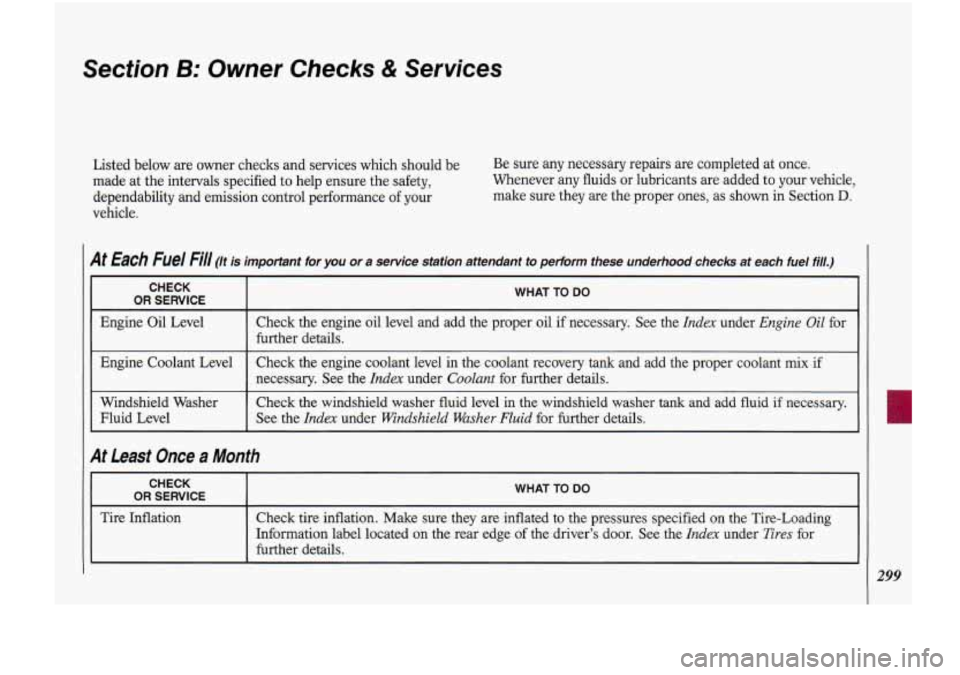
Section B: Owner Checks & Services
Listed below are owner checks and services which should be Be sure any necessary repairs are completed at once.
made at the intervals specified to help ensure the safety, Whenever any fluids or lubricants are added to your vehicle,
dependability and emission control performance of your make sure they are the proper ones, as
shown in Section D.
vehicle.
At Each Fuel Fill (/t is important for you or a service station attendant to perform these underhood check\
s at each fuel fill.)
CHECK
OR SERVICE I WHAT TO DO
Engine Oil Level Check the engine oil level and add the proper oil if necessary. See the Index under Engine Oil for
further details.
Engine Coolant Level
See the
Index under Windshield Washer Fluid for further details.
Fluid Level Check the
windshield washer fluid level in the windshield washer
tank and add fluid if necessary. Windshield Washer
Check the engine coolant
level in the coolant recovery tank and add the proper coolant mix if
~~ ~ ~~
necessary. See the Index under Coolant for further details.
At Least Once a Month
CHECK
I OR SERVICE I WHAT TO DO
Tire Inflation
Check tire inflation. Make sure they are inflated to the pressures specified on the Tire-Loading
~~ ~
Information label located on the rear edge of the driver’s door. See the Index under Tires for
further details.
r
L
299